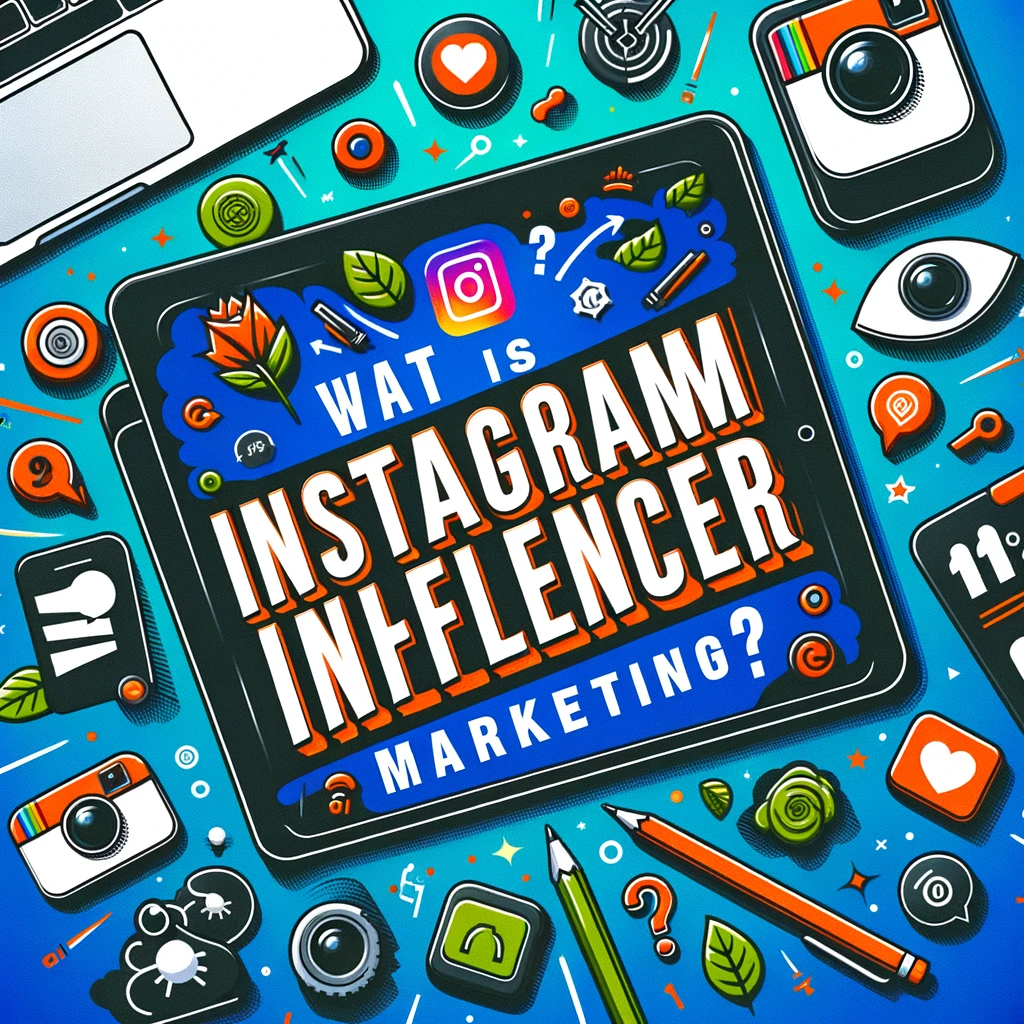In the ever-evolving landscape of digital marketing, Instagram Influencer Marketing has emerged as a powerful strategy.
It’s a tool that brands are leveraging to reach their target audience, boost engagement, and drive conversions.
But what exactly is Instagram Influencer Marketing?
Simply put, it’s a form of social media marketing that uses endorsements and product mentions from influencers. These are individuals who have a dedicated social following and are viewed as experts within their niche.

In this comprehensive guide, we delve into the intricacies of Instagram Influencer Marketing as it stands for the year 2024.
We aim to provide a deep understanding of how this form of marketing works on Instagram.
We’ll explore the benefits it offers, the strategies involved, and how to measure its effectiveness.
We’ll also look at the latest trends, tools, and best practices for businesses looking to leverage Instagram for influencer marketing campaigns.
Whether you’re a digital marketer, a social media manager, a brand strategist, or a business owner, this guide is for you.
Content creators and anyone interested in understanding and utilizing Instagram influencer marketing will also find this guide valuable.
We’ll cover everything from the evolution of influencer marketing on social platforms to the impact of Instagram’s algorithm changes on influencer marketing.
We’ll discuss the role of content engagement in influencer marketing success and how to identify and collaborate with the right influencers for your brand.
We’ll also delve into the importance of niche markets in targeted influencer campaigns and strategies for growing Instagram followers and enhancing social media presence.
By the end of this guide, you’ll have a solid grasp of Instagram Influencer Marketing and how to leverage it for your brand’s success in 2024.
So, let’s dive in and explore the world of Instagram Influencer Marketing.
Chapter 1: Understanding Instagram Influencer Marketing
Instagram Influencer Marketing is a dynamic and multifaceted field.
To fully grasp its potential, it’s crucial to understand its roots, its current state, and the platform that powers it.
In this chapter, we’ll explore the evolution of influencer marketing on Instagram, define what it means in 2024, and discuss the significance of Instagram as a social media powerhouse.

The Evolution of Influencer Marketing on Instagram
Influencer marketing on Instagram has come a long way since its inception.
In the early days, brands would simply reach out to celebrities to endorse their products.
However, as Instagram grew, so did the concept of ‘influence’.

Today, influencers are not just celebrities.
They can be anyone with a dedicated following, from fashion bloggers and fitness gurus to food enthusiasts and travel vloggers.
This shift has allowed brands to tap into niche markets, making their marketing efforts more targeted and effective.
Defining Instagram Influencer Marketing in 2024
In 2024, Instagram Influencer Marketing is about building authentic relationships.
It’s about partnering with influencers who align with your brand’s values and can genuinely connect with your target audience.
Here are some key aspects of Instagram Influencer Marketing in 2024:
- Authenticity: Influencers are expected to promote products they genuinely use and love.
- Transparency: Clear disclosure of partnerships is a must to maintain trust with followers.
- Quality over quantity: Brands prefer influencers with high engagement rates over those with large followings.
The Significance of Instagram as a Social Media Powerhouse
Instagram is more than just a photo-sharing app.
It’s a platform where users discover new products, get inspired, and connect with their favorite brands.
With over a billion active users, Instagram offers a vast audience for brands to tap into.
Moreover, its visual nature makes it the perfect platform for showcasing products in a creative and engaging way.
Finally, Instagram’s features like Stories, IGTV, and Shopping have further enhanced its potential as a marketing platform.
In the next chapter, we’ll delve into the mechanics of Instagram Influencer Marketing.
Chapter 2: The Mechanics of Instagram Influencer Marketing
Understanding the mechanics of Instagram Influencer Marketing is key to leveraging its full potential.
In this chapter, we’ll explore how Instagram’s algorithm influences marketing, how to identify and collaborate with the right influencers, and the role of content engagement and niche markets.

How Instagram’s Algorithm Influences Marketing
Instagram’s algorithm plays a significant role in determining the success of your influencer marketing campaigns.
It decides what content gets seen by users and in what order.

Understanding how the algorithm works can help you optimize your content for better visibility and engagement.
Here are some key factors that Instagram’s algorithm considers:
- Interest: The algorithm predicts what content a user might care about most.
- Recency: Recent posts are more likely to appear at the top of the feed.
- Relationship: Users are more likely to see posts from people they interact with often.
Identifying and Collaborating with the Right Influencers
Finding the right influencers for your brand is a critical step in your Instagram Influencer Marketing strategy.
The right influencers can help you reach your target audience, increase brand awareness, and drive conversions.

Here are some factors to consider when identifying influencers:
- Relevance: The influencer’s content should align with your brand and product.
- Reach: Consider the influencer’s follower count and their ability to reach your target audience.
- Engagement: Look at the influencer’s engagement rate, including Instagram likes, comments, Instagram views, and shares.
Once you’ve identified potential influencers, the next step is to reach out and propose a collaboration.
Remember, successful collaborations are built on mutual benefit and respect.
The Role of Content Engagement and Niche Markets
Content engagement is a key metric in Instagram Influencer Marketing.
It measures how users interact with an influencer’s content, including likes, comments, shares, and saves.
High engagement rates indicate that the influencer’s audience is active and interested in their content.

Niche markets, on the other hand, refer to specific segments of the market that have unique needs and preferences.
Influencers who cater to niche markets have a highly targeted and engaged audience.
This makes them valuable partners for brands looking to reach specific customer segments.
In the next chapter, we’ll discuss how to craft an effective Instagram Influencer Marketing strategy.
Chapter 3: Crafting Your Instagram Influencer Marketing Strategy
Crafting a successful Instagram Influencer Marketing strategy requires careful planning and execution.
In this chapter, we’ll guide you through setting clear campaign goals and objectives, developing a comprehensive campaign strategy, and measuring success using marketing metrics and ROI.

Setting Clear Campaign Goals and Objectives
Before you start your influencer marketing campaign, it’s crucial to set clear goals and objectives.
These will guide your strategy and help you measure success.

Your goals could include increasing brand awareness, driving website traffic, or boosting product sales.
Your objectives, on the other hand, should be specific, measurable, achievable, relevant, and time-bound (SMART).
For example, you might aim to increase website traffic by 20% in the next three months through your influencer marketing campaign.
Developing a Campaign Strategy: From Planning to Execution
Once you’ve set your goals and objectives, the next step is to develop your campaign strategy.
This involves several steps, from identifying the right influencers to creating engaging content.
Here’s a step-by-step guide to developing your campaign strategy:
- Identify the right influencers: Look for influencers who align with your brand and have a highly engaged audience.
- Define your content strategy: Decide what type of content you want the influencers to create and how often they should post.
- Set your budget: Determine how much you’re willing to spend on the campaign.
- Reach out to influencers: Send a personalized message to each influencer, proposing a collaboration.
- Negotiate and sign contracts: Agree on the terms of the collaboration, including compensation, content guidelines, and timelines.
- Launch the campaign: Ensure that all parties understand their roles and responsibilities.
- Monitor the campaign: Keep track of the campaign’s progress and make adjustments as necessary.

Measuring Success: Marketing Metrics and ROI
Measuring the success of your influencer marketing campaign is crucial to understanding its effectiveness.
This involves tracking key marketing metrics and calculating your return on investment (ROI).
Here are some key metrics to track:
- Reach: The number of unique users who saw the post.
- Engagement: The number of likes, comments, shares, and saves the post received.
- Conversions: The number of users who completed a desired action, such as making a purchase or signing up for a newsletter.
- ROI: The return on investment, calculated by dividing the net profit by the total investment.
Remember, the success of your campaign should be measured against the goals and objectives you set at the beginning.
In the next chapter, we’ll explore the latest trends and best practices in Instagram Influencer Marketing.
Chapter 4: Trends and Best Practices in Instagram Influencer Marketing
In this chapter, we’ll delve into the latest trends and best practices in Instagram Influencer Marketing.
We’ll discuss the rise of micro and nano influencers, the importance of authenticity and transparency, and how to leverage new features and marketing tools.

The Rise of Micro and Nano Influencers
In recent years, there’s been a shift in the influencer landscape.
Brands are increasingly partnering with micro and nano influencers.

Micro influencers, with 10,000 to 50,000 followers, and nano influencers, with 1,000 to 10,000 followers, often have higher engagement rates than their mega-influencer counterparts.
Their audiences are usually more niche, leading to more meaningful interactions and higher conversion rates.
The Importance of Authenticity and Transparency
Authenticity and transparency are key in influencer marketing.
Influencers who are genuine and transparent in their brand partnerships tend to have more trust and engagement from their followers.
Here are some ways to ensure authenticity and transparency in your influencer marketing campaigns:
- Choose influencers who genuinely like your brand and products.
- Encourage influencers to share their honest opinions about your products.
- Ensure influencers disclose their partnerships with your brand, as per FTC guidelines.

Transparency not only builds trust with the audience but also helps avoid legal issues.
Leveraging New Features and Marketing Tools
Instagram is constantly rolling out new features and tools, many of which can be leveraged for influencer marketing.
Features like Instagram Stories, IGTV, and Shopping have opened up new ways for influencers to engage with their audience and promote brands.
Here are some ways to leverage these features:
- Instagram Stories: Influencers can use Stories to share behind-the-scenes content, conduct Q&As, or give product demonstrations.
- IGTV: This feature is great for longer-form content, like interviews or detailed product reviews.
- Shopping: Influencers can tag products in their posts, making it easy for followers to shop directly from Instagram.

Staying up-to-date with the latest Instagram features and marketing tools can help you maximize your influencer marketing efforts.
In the next chapter, we’ll discuss how to build and measure brand engagement through Instagram Influencer Marketing.
Chapter 5: Building and Measuring Brand Engagement
In this chapter, we’ll explore how to build and measure brand engagement through Instagram Influencer Marketing.
We’ll discuss how to foster audience engagement and brand awareness, the role of content creation and distribution, and how to analyze content performance and engagement metrics.

Fostering Audience Engagement and Brand Awareness
Audience engagement and brand awareness are two key objectives of Instagram Influencer Marketing.
Influencers, with their loyal and engaged followers, can help brands reach a wider audience and increase brand awareness.

Here are some strategies to foster audience engagement and brand awareness:
- Collaborate with influencers who share your brand values and aesthetics.
- Encourage influencers to create engaging content that resonates with their audience.
- Leverage Instagram features like Stories, IGTV, and Shopping to promote your brand.
Remember, genuine and meaningful engagement can lead to higher brand awareness and loyalty.
The Role of Content Creation and Distribution
Content is at the heart of Instagram Influencer Marketing.
Influencers are content creators who know how to engage their audience with compelling visuals and narratives.
Here are some tips for effective content creation and distribution:
- Collaborate with influencers on content creation to ensure it aligns with your brand messaging.
- Encourage influencers to create a mix of content types, like posts, Stories, and IGTV videos.
- Plan a content distribution strategy that aligns with your marketing objectives.

Remember, the right content can engage the audience, convey your brand message, and drive action.
Analyzing Content Performance and Engagement Metrics
Analyzing content performance and engagement metrics is crucial to measure the success of your influencer marketing campaigns.
Metrics like likes, comments, shares, saves, and views can provide insights into how well the content is resonating with the audience.
Other metrics like click-through rates, conversion rates, and ROI can help measure the direct impact of the influencer marketing campaign on your business goals.
Remember, regular analysis and optimization can help improve your influencer marketing strategy and achieve better results.
In the next chapter, we’ll delve into the economics of Instagram Influencer Marketing.
Chapter 6: The Economics of Instagram Influencer Marketing
In this chapter, we’ll delve into the economics of Instagram Influencer Marketing.
We’ll discuss the market size and influencer revenue models, how to budget for your influencer marketing campaign, and influencer statistics and compensation structures.

Market Size and Influencer Revenue Models
The market size of Instagram Influencer Marketing has been growing rapidly over the years.
According to a report by Business Insider, the influencer marketing industry is set to reach $15 billion by 2022.

Influencers generate revenue through various models.
Some influencers charge a flat fee per post, while others may charge based on the number of followers or the engagement rate.
Some influencers also earn revenue through affiliate marketing, where they earn a commission for every sale made through their referral link.
Remember, understanding the market size and influencer revenue models can help you plan your budget and negotiate with influencers.
Budgeting for Your Influencer Marketing Campaign
Budgeting for your influencer marketing campaign is a crucial step.
Here are some factors to consider when budgeting:
- The number of influencers you plan to collaborate with.
- The type of content you want the influencers to create.
- The reach and engagement rate of the influencers.
Remember, it’s important to allocate a budget that aligns with your marketing objectives and expected ROI.
Influencer Statistics and Compensation Structures
Influencer statistics like follower count, engagement rate, and audience demographics can influence their compensation.
Influencers with a large following and high engagement rate typically command higher fees.
However, micro-influencers, despite having fewer followers, can offer higher engagement rates and more targeted audiences.
Here are some common compensation structures in influencer marketing:
- Pay per post: The influencer is paid a flat fee for each post.
- Commission: The influencer earns a percentage of sales made through their referral link.
- Free products or services: The influencer receives free products or services in exchange for promotion.
Remember, understanding influencer statistics and compensation structures can help you negotiate fair and mutually beneficial agreements.
In the next chapter, we’ll discuss the legal and ethical considerations in Instagram Influencer Marketing.
Chapter 7: Legal and Ethical Considerations
In this chapter, we’ll explore the legal and ethical considerations in Instagram Influencer Marketing.
We’ll discuss how to navigate contracts and legal agreements, and the importance of ensuring advertising transparency and consumer trust.

Navigating Contracts and Legal Agreements
When collaborating with influencers, it’s crucial to have a clear and comprehensive contract.
This contract should outline the terms of the collaboration, including the deliverables, timeline, compensation, and usage rights.
Remember, it’s always advisable to seek legal counsel when drafting and reviewing contracts to ensure your interests are protected.
Ensuring Advertising Transparency and Consumer Trust
In the world of influencer marketing, transparency is key.
In many regions, influencers are required by law to disclose sponsored content.
This can be done by using hashtags like #ad, #sponsored, or #partnership.
Here are some best practices for ensuring advertising transparency:
- Clearly disclose sponsored content.
- Be honest about product reviews and experiences.
- Avoid making misleading or unsubstantiated claims.
Remember, maintaining transparency not only complies with legal requirements but also builds consumer trust.
In the next chapter, we’ll look into the future of Instagram Influencer Marketing.
Chapter 8: The Future of Instagram Influencer Marketing
As we move forward, Instagram Influencer Marketing continues to evolve.
In this chapter, we’ll explore the future of this dynamic marketing strategy.
We’ll delve into emerging technologies, industry growth, and predictions for the future.
We’ll also discuss how to prepare for these changes to stay ahead of the curve.

Emerging Technologies and Industry Growth
Emerging technologies are reshaping Instagram Influencer Marketing.
Artificial Intelligence (AI) and Machine Learning (ML) are being used to analyze data, predict trends, and personalize content.
Virtual Reality (VR) and Augmented Reality (AR) are providing immersive experiences, opening new avenues for influencer marketing.
The industry is also witnessing significant growth.
According to a report by Business Insider, the influencer marketing industry is set to reach $15 billion by 2022.

Predictions and Preparing for Changes
Looking ahead, we can expect several changes in Instagram Influencer Marketing.
Micro and nano influencers are likely to gain more prominence due to their high engagement rates.
Brands may also start to focus more on long-term partnerships with influencers, rather than one-off campaigns.
Here are some ways to prepare for these changes:
- Stay updated with the latest trends and technologies.
- Invest in analytics tools to measure the effectiveness of your campaigns.
- Build strong relationships with influencers for long-term collaborations.
In the next section, we’ll wrap up this guide with some key takeaways and next steps.
Conclusion: Integrating Instagram Influencer Marketing into Your Digital Strategy
As we’ve seen, Instagram Influencer Marketing is a powerful tool.
It can help brands reach their target audience, boost engagement, and drive sales.
However, it’s not a standalone strategy.
It should be integrated into your overall digital marketing plan.

Key Takeaways and Next Steps
In this guide, we’ve covered the ins and outs of Instagram Influencer Marketing.
We’ve explored its mechanics, strategies, trends, and future predictions.
Now, it’s time to put this knowledge into action.
Start by identifying your goals, finding the right influencers, and crafting a compelling campaign.
Monitor your campaign’s performance, adjust as needed, and always keep an eye on the latest trends.
Remember, successful Instagram Influencer Marketing is about building genuine relationships and delivering valuable content to your audience.
With the right approach, you can leverage this powerful marketing tool to boost your brand’s online presence and achieve your business goals.
Good luck on your Instagram Influencer Marketing journey!









